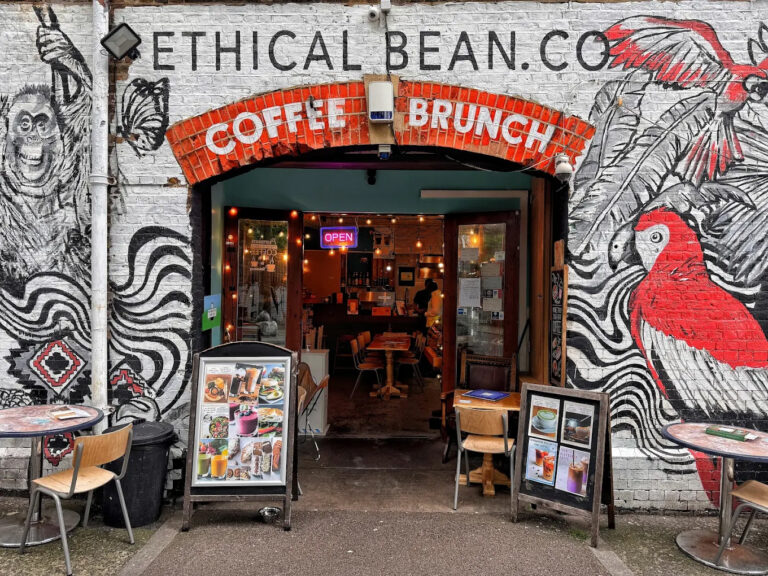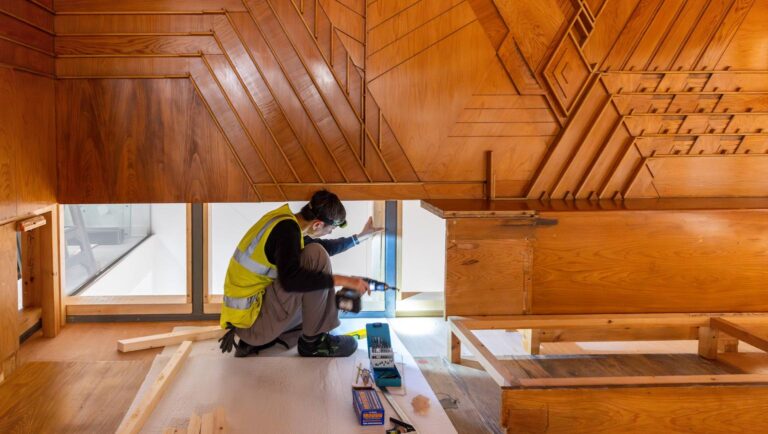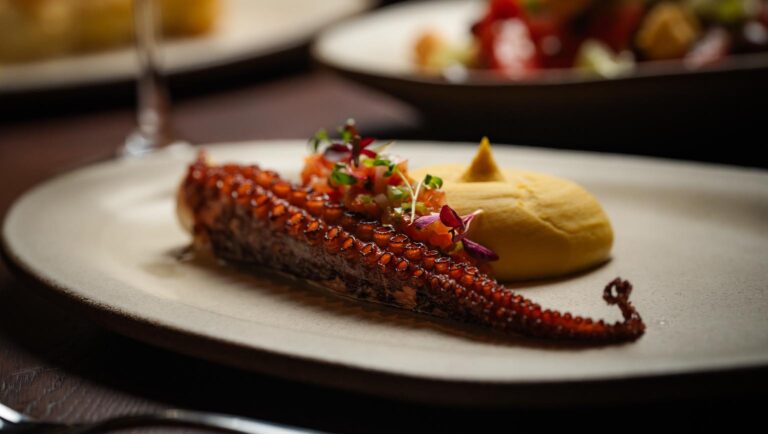
The Best Eating & Drinking on Fish Island
Your timely reminder to go visit these amazing restaurants, bars and cafes this summer while we wait for better bridge access…
What first possessed you to get into the laborious world of stop motion animation?
Growing up in Derbyshire there wasn’t that much around, so you had to be very creative with what you could do. I learned loads about how to manufacture and put things together working with my dad for a few years, then decided to do illustration in London, but I was always making sculptural things and automated toys. There was a TV programme called Formations, which I caught one night interviewing people that were making little stop motion short films. It was this eureka moment, watching it and thinking, ‘oh wow, these guys build everything, they animate it and it comes alive,’ and I thought: this is it. This is exactly the sort of thing I’ve been doing all these years. I’m perfectly suited for this.
There was no plan though, I found out what I liked, went for it and made a couple of short films. One was about a troll that lived on the moon, and the other was a music video for the famous song Stand By Me, made using plasticine. I got work with that pretty much straight away – making the tea on acommercial for Golden Wonder crisps. That was a classic apprenticeship path back then.
Was there any particular person or company that you picked up some great advice from along the way?
I’ve been really lucky and met some amazing people and worked with some of the best on this journey. Early on I worked with a fantastic director called Will Biles who gave me a lot of encouragement. Mick Foley’s company called Puppetoon Productions in Soho I really have to credit for giving me that first break. Then there’s Simon Quinn from the Puppet Factory, Makinnon and Saunders in Manchester, Aardman Animations in Bristol, all of which are amazing places where I got to work alongside really talented people. The better the people you work with, the better you become, because you pick up such good experience, including tricks and skills from each of them. Dennis Russo over in Stockwell gave me an amazing break and got me into a new world again when I was working with him. And then there’s Ronnie McDonald, who is working for me now and originally I used to work for him!
How did you end up in Hackney Wick?
I’d lived in Portland in the US for a year working on the movie Coraline, then moved to Switzerland to make Max and Co. When I came back to work on Fantastic Mr. Fox, which was shooting at Three Mills Studios in Bromley-by-Bow, another really big film came in at the studios in 2003 called Corpse Bride. I just thought, I’ve done all this travelling working on different projects, it would be nice to stay in this neighbourhood.

Do you get inspired by this area and all its interesting characters?
What I do is observe people and things. One of the films we worked on was called Isle of Dogs and I had a chocolate Labrador at the time, so I knew a lot of people with dogs. A lot of the characters in that film have come from local residents’ pets. If you look hard enough, you’ll probably spot one that looks familiar. Sometimes, we might photograph someone and think that they are brilliant, and we’ll have them as a face in a film. It’s inevitable we’re always looking at people and how we might make them into characters.
You mentioned in a previous interview that Isle of Dogs includes a one-minute sushi-making scene that took seven months to make?
It was the best part of a year. To make things look realistic we filmed a very famous sushi chef in New York, because how he cooked and held things was beautiful. It was really informative to see how the knife cuts in a certain direction and how he holds it and moves.
It’s a good scene to look back on, and feels worth it all when you see it. It was one shot, so everything had to be worked out. There was a massive crew – I had 68 people working for me on Isle of Dogs.
The film was a three-year piece of work for me. So in the 25 years I’ve been making films, I’ve only produced about eight hours of footage. It is a commitment to a medium. I absolutely love it, there’s nothing like it where you have the ability to make anything – and it’s real, it’s in front of you.
Your film Save Ralph is really important as it deals with stopping animal testing. It feels particularly effective because of the expressions of the animals. How do you get that emotion across in your puppets?
What we are trying to do is trying to make something inanimate completely come to life. The original Greek meaning is to breathe life, which is what we’re trying to do. Ralph is a really good example, he’s got to be really emotive and connect with the person viewing it all, so how? Eyes are one of the amazing things. If you don’t move the rest of the puppet and just blink the eyes, that will keep them alive in the viewer’s mind, so if the puppets cry you can connect with them. If everything else is correct and nothing is going to break your suspension of belief, then you go on that emotional journey with the character. Of course, the script and storyline have to be good too, but if you don’t question anything in the world in that moment, you’re totally wrapped into it all. If that little rabbit can bunch his eyes together, or lower his ears in a soft way, you know what he’s experiencing even if he isn’t saying anything. When we’re making these things, we’re desperately trying to work out how we’re going to give it this impact, believability, charisma and empathy.
I think Save Ralph will be one of those projects that we’re proud about for a long time. We’re winning quite a lot of awards for it at the moment, as we’ve entered it into all the film festivals. And it’s funny, because you want it to be a really good, upbeat and lively experience for audiences, but then you know that a lot of people are going to cry when they watch it. It’s had around 13 million views online so far, and the impact has managed to change the law in three countries. Spencer Susser, the director, absolutely blew it out of the water, it was a great idea. But to think that little film that was shot in the room next door has actually gone on and changed the law…

That’s the power of art! But it’s also the fact that it felt so real. Do you think that if it were made using CGI and looked computerised, it could have had such a heartstring-pulling effect?
If you do stop motion, you know it’s real, it’s a very tactile thing, so using this technique was a very conscious decision. When Ralph is chewing and everything is coming out of his mouth, or when he’s moving away from a syringe, you know that’s a real thing, which connects you in a totally different way to if it was 2D, or CG. Both of those mediums can do amazing things, but it’s about picking the right medium for the job. Ralph in stop motion was the perfect thing, and everybody connected to that. I don’t think there’s anybody that couldn’t be brought to tears or at least sign the petition from watching it.
Do you have any time for passion projects?
Save Ralph was a bit of a passion project because they couldn’t really couldn’t afford to do it. I decided to turn a year of the company into helping getting that one done. It was a project I was quite passionate about anyway, as I thought it was a good thing to do and I really wanted to help them. It became much bigger than even I’d anticipated, but once we’d started making Ralph and then the sets, we couldn’t really let it go, so I just kept investing my efforts into that as best as I could.
I’ve got a couple of little short film ideas I’m trying to do, and have been for the last 20 years. So that’ll keep going until I eventually get them done. There’s so many interesting things to make that your own stuff tends to get bumped to the back of the list. But it’s still alive, it’s still going on. Everybody that works here, I encourage everybody to come up with short ideas and make them. There’s not only the model and puppet making and the set building here, there’s also the film studio next door, and we’ve got all of our own equipment. So between the projects we do for the people, I would love the team who work here to then make their own short films.

It doesn’t look like there’s this busy hive of creative energy going on from the outside, but your Arch Model Studios is a busy place. Did you ever dream it would grow to be like this?
It’s a bit surreal when you come inside. When we were working on Corpse Bride, we were sitting in the canteen and we turned to each other and said how amazing it was to be working on the last ever stop motion film. Because at that time computer animation was really on the ascendency, and we all thought the technique will move that way. Then a couple of big champions like Tim Burton and Wes Anderson came in and made other films. I took six people from Hackney with me over to America to set up LAIKA in Oregon and we made Coraline, and then they all then went on to do other things. So it’s not only here, it’s like a circus in our world. We all work closely together. If I go to do a film elsewhere, I take crew, and we have our own collaborations, too. But we all come back to this area, this is the hub. Since I set up Arch Model Studios this is where we return and it’s become centred here in Hackney Wick.
The studios produce all kinds of different projects, so which current ones are you especially excited about?
I was working with an amazing puppeteer called Ollie Taylor over in Spain last year on Wes Anderson’s next film that was so much fun to do. We were lucky enough to make a very cool, funky puppet for that one, so I’m looking forward to seeing that on the big screen. We’ve done stuff for Hans Christian Anderson’s Museum, which they’re opening any day, which was great as they’re the stories I remember growing up with. Our ad for Oatly is just out and we’ve done one for Three Mobile which is a big dancing middle-aged three-man puppet that’s incredibly weird, but I’m really pleased we made it because weird is good. We keep getting weirder and weirder requests, so we try and answer all of them. That’s what I always wanted to do with this place, to be really diverse.
Find out more at: ams.london

Your timely reminder to go visit these amazing restaurants, bars and cafes this summer while we wait for better bridge access…

The twist and turns of post-Olympics decision-making that brought 250,000 objects to Here East

This thoroughly modern restaurant may be far from the taverna, but it’s filled with Mediterranean flavours, and much more
A joint venture in collaborative local media from:


In partnership with

Regulated by IMRESSS, the Independent Monitor for the Press CIC.
For more info on our complaints policy, or to make a complaint, visit FAQ.
